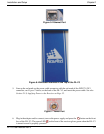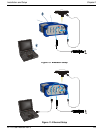
24 DL-V3 User Manual Rev 3
Chapter 1 Introduction
Table 2 lists the models, each capable of multiple positioning modes of operation:
Table 2: GPS Positioning Modes of Operation
1.2 OPERATING MODES
The DL-V3 can either be controlled by a host computer or be set up for stand-alone operation.
• Controlled Operation: A host computer can transmit logging parameters, receive collected data,
and turn the DL-V3 on or off. Whenever the DL-V3 is connected to a power source (regardless of
whether the DL-V3 is turned “on” or “off”), it detects if there is a host computer connected to one
of its serial ports. If a host computer is found, and there is serial port activity from a host
computer to the DL-V3, the DL-V3 powers up. If the DL-V3’s predefined POWERUP group, see
also Section 4.2.1, Receiver Groups on Page 57, exists in the DL-V3, the DL-V3 runs the
POWERUP group, otherwise the DL-V3 begins to search for satellites and waits for commands
from the host computer.
Only specific serial ports have wake-up capability on data activity. For example, the USB,
Ethernet or Bluetooth® ports do not.
• Stand-Alone Operation: Once the DL-V3 receives configuration commands from a host
computer, it operates according to these parameters. For example, data collection can be
configured in advance by setting up a group to repeat continually.
Refer also to the OEMV Family Installation and Operation User Manual for information on receiver
communications and operation.
Modes of Operation
a
a. For a discussion on Positioning Modes of Operation, please refer to the OEMV Family
Installation and Operation User Manual.
DL-V3 Model
L1 RT20 L1/L2 RT2
HP/
XP
VB
S
Single point ¸ ¸ ¸ ¸ ¸ ¸
Pseudorange differential corrections ¸ ¸ ¸ ¸ ¸ ¸
RT20 pseudorange and carrier-phase double
differencing
¸¸¸
RT2 pseudorange and carrier-phase double
differencing:
¸¸
Post-processed RTK-type accuracy ¸ ¸ ¸ ¸ ¸ ¸
OmniStar HP/XP ¸
OmniStar VBS and CDGPS ¸ ¸


















